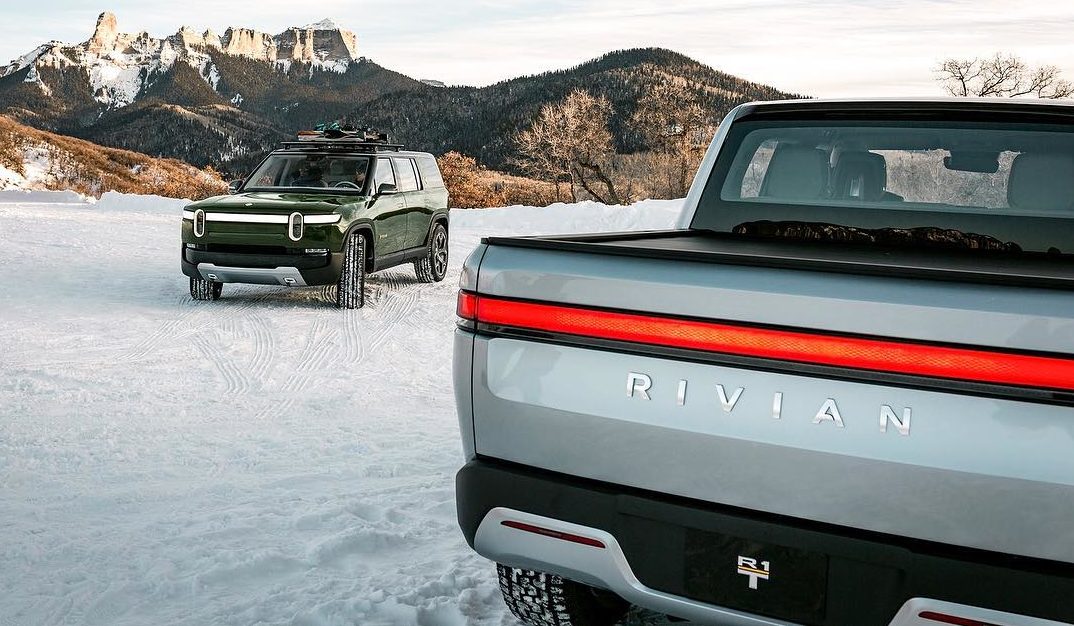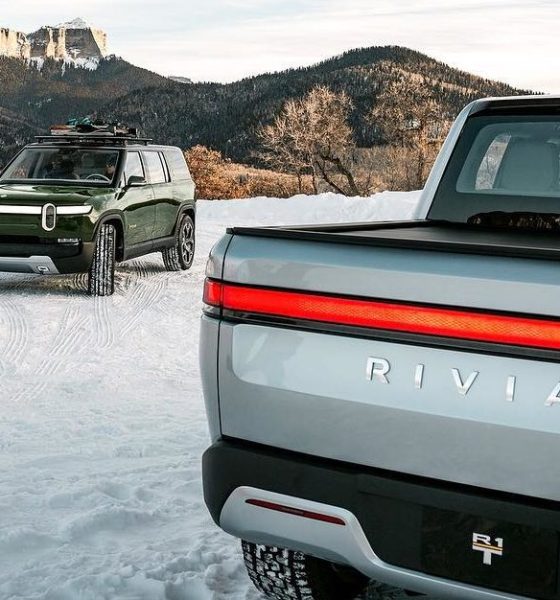Rivian CEO RJ Scaringe recently shared some new insights about the R1T pickup truck and the R1S SUV in an interview with auto publication The Drive. During his interview, Scaringe discussed Rivian’s battery technology, the company’s plans for the vehicles charging systems, and the media’s usual comparisons between himself and Tesla CEO Elon Musk.
Rivian’s trucks are luxury adventure vehicles, and they are designed to carry several people in off-road conditions. As such, it is pertinent for Rivians to have the best battery technology available. When asked by the publication about the R1T and the R1S’s capability to charge its batteries, the CEO noted that the all-electric trucks would be capable of putting 200 miles of range in 30 minutes. With their 180 kWh battery packs, Scaringe pointed out that a 400-mile range is very feasible.
In the event that Rivian owners find themselves in remote areas without easy access to a charging station, Scaringe noted that the company is preparing solutions that will enable drivers to recharge their vehicles off the grid, such as auxiliary battery packs. The CEO also added that the company would allow vehicle-to-vehicle charging, allowing two Rivians to charge each other. “We’ve designed the vehicle so you can have auxiliary battery packs. You can also charge Rivian-to-Rivian, which is a neat thing. You connect the two vehicles, and then I could hand you some electrons,” Scaringe said.
These solutions will most definitely make Rivian’s vehicles an attractive purchase for the luxury adventure demographic, particularly among overlanders, who are known for taking long trips off the grid. Using Rivian’s vehicle-to-vehicle charging system, groups of overlanders can simply utilize a Rivian truck loaded with auxiliary battery packs as a designated charger for other vehicles that will be used primarily for camping, or even cooking, for that matter.
Being an electric car maker and having a striking physical resemblance to Clark Kent, Rivian CEO RJ Scaringe has been compared to Tesla’s Elon Musk, whose bold, ambitious, and rockstar CEO persona has brought comparisons to billionaire-superhero Tony Stark. Back in February alone, Forbes even wrote an article about Scaringe, dubbing him and Rivian as “Tesla’s worst nightmare.” In his recent interview, the Rivian CEO noted that this is far from the truth.
“In so far as we both build electric cars, we’re similar. Other than that, we’re building very different types of products for different companies. I say that with the deepest admiration and respect for what they’ve done. Tesla has really helped make electric cars exciting. They’ve helped shift the world towards electrification. We as Rivian, and we as the planet, owe them a thank you. But I think there’s a need for more flavors.
“The world needs more than one new electric and new innovator within the space, and we’ve been thoughtful also to not try to compete directly in the space they’re in. If we’re going after that type of a use case, I think it doesn’t make any sense. There are companies that are doing that. There’s a number of Chinese backed companies that are doing products that are very similar to the brand experience and sort of product experience that you get with Tesla,” he said.
Since unveiling the R1T pickup truck and the R1S SUV last year, Rivian has received overwhelming support from the electric car community, thanks in part to the design and capabilities of its two vehicles. The company has also been receiving support from large investors such as Ford and Amazon, both of which have helped Rivian raise over $1 billion in investments.

Elon Musk
Elon Musk and Tesla AI Director share insights after empty driver seat Robotaxi rides
The executives’ unoccupied tests hint at the rapid progress of Tesla’s unsupervised Robotaxi efforts.

Tesla CEO Elon Musk and AI Director Ashok Elluswamy celebrated Christmas Eve by sharing personal experiences with Robotaxi vehicles that had no safety monitor or occupant in the driver’s seat. Musk described the system’s “perfect driving” around Austin, while Elluswamy posted video from the back seat, calling it “an amazing experience.”
The executives’ unoccupied tests hint at the rapid progress of Tesla’s unsupervised Robotaxi efforts.
Elon and Ashok’s firsthand Robotaxi insights
Prior to Musk and the Tesla AI Director’s posts, sightings of unmanned Teslas navigating public roads were widely shared on social media. One such vehicle was spotted in Austin, Texas, which Elon Musk acknowleged by stating that “Testing is underway with no occupants in the car.”
Based on his Christmas Eve post, Musk seemed to have tested an unmanned Tesla himself. “A Tesla with no safety monitor in the car and me sitting in the passenger seat took me all around Austin on Sunday with perfect driving,” Musk wrote in his post.
Elluswamy responded with a 2-minute video showing himself in the rear of an unmanned Tesla. The video featured the vehicle’s empty front seats, as well as its smooth handling through real-world traffic. He captioned his video with the words, “It’s an amazing experience!”
Towards Unsupervised operations
During an xAI Hackathon earlier this month, Elon Musk mentioned that Tesla owed be removing Safety Monitors from its Robotaxis in Austin in just three weeks. “Unsupervised is pretty much solved at this point. So there will be Tesla Robotaxis operating in Austin with no one in them. Not even anyone in the passenger seat in about three weeks,” he said. Musk echoed similar estimates at the 2025 Annual Shareholder Meeting and the Q3 2025 earnings call.
Considering the insights that were posted Musk and Elluswamy, it does appear that Tesla is working hard towards operating its Robotaxis with no safety monitors. This is quite impressive considering that the service was launched just earlier this year.
Elon Musk
Starlink passes 9 million active customers just weeks after hitting 8 million
The milestone highlights the accelerating growth of Starlink, which has now been adding over 20,000 new users per day.

SpaceX’s Starlink satellite internet service has continued its rapid global expansion, surpassing 9 million active customers just weeks after crossing the 8 million mark.
The milestone highlights the accelerating growth of Starlink, which has now been adding over 20,000 new users per day.
9 million customers
In a post on X, SpaceX stated that Starlink now serves over 9 million active users across 155 countries, territories, and markets. The company reached 8 million customers in early November, meaning it added roughly 1 million subscribers in under seven weeks, or about 21,275 new users on average per day.
“Starlink is connecting more than 9M active customers with high-speed internet across 155 countries, territories, and many other markets,” Starlink wrote in a post on its official X account. SpaceX President Gwynne Shotwell also celebrated the milestone on X. “A huge thank you to all of our customers and congrats to the Starlink team for such an incredible product,” she wrote.
That growth rate reflects both rising demand for broadband in underserved regions and Starlink’s expanding satellite constellation, which now includes more than 9,000 low-Earth-orbit satellites designed to deliver high-speed, low-latency internet worldwide.
Starlink’s momentum
Starlink’s momentum has been building up. SpaceX reported 4.6 million Starlink customers in December 2024, followed by 7 million by August 2025, and 8 million customers in November. Independent data also suggests Starlink usage is rising sharply, with Cloudflare reporting that global web traffic from Starlink users more than doubled in 2025, as noted in an Insider report.
Starlink’s momentum is increasingly tied to SpaceX’s broader financial outlook. Elon Musk has said the satellite network is “by far” the company’s largest revenue driver, and reports suggest SpaceX may be positioning itself for an initial public offering as soon as next year, with valuations estimated as high as $1.5 trillion. Musk has also suggested in the past that Starlink could have its own IPO in the future.
News
NVIDIA Director of Robotics: Tesla FSD v14 is the first AI to pass the “Physical Turing Test”
After testing FSD v14, Fan stated that his experience with FSD felt magical at first, but it soon started to feel like a routine.

NVIDIA Director of Robotics Jim Fan has praised Tesla’s Full Self-Driving (Supervised) v14 as the first AI to pass what he described as a “Physical Turing Test.”
After testing FSD v14, Fan stated that his experience with FSD felt magical at first, but it soon started to feel like a routine. And just like smartphones today, removing it now would “actively hurt.”
Jim Fan’s hands-on FSD v14 impressions
Fan, a leading researcher in embodied AI who is currently solving Physical AI at NVIDIA and spearheading the company’s Project GR00T initiative, noted that he actually was late to the Tesla game. He was, however, one of the first to try out FSD v14.
“I was very late to own a Tesla but among the earliest to try out FSD v14. It’s perhaps the first time I experience an AI that passes the Physical Turing Test: after a long day at work, you press a button, lay back, and couldn’t tell if a neural net or a human drove you home,” Fan wrote in a post on X.
Fan added: “Despite knowing exactly how robot learning works, I still find it magical watching the steering wheel turn by itself. First it feels surreal, next it becomes routine. Then, like the smartphone, taking it away actively hurts. This is how humanity gets rewired and glued to god-like technologies.”
The Physical Turing Test
The original Turing Test was conceived by Alan Turing in 1950, and it was aimed at determining if a machine could exhibit behavior that is equivalent to or indistinguishable from a human. By focusing on text-based conversations, the original Turing Test set a high bar for natural language processing and machine learning.
This test has been passed by today’s large language models. However, the capability to converse in a humanlike manner is a completely different challenge from performing real-world problem-solving or physical interactions. Thus, Fan introduced the Physical Turing Test, which challenges AI systems to demonstrate intelligence through physical actions.
Based on Fan’s comments, Tesla has demonstrated these intelligent physical actions with FSD v14. Elon Musk agreed with the NVIDIA executive, stating in a post on X that with FSD v14, “you can sense the sentience maturing.” Musk also praised Tesla AI, calling it the best “real-world AI” today.










